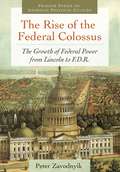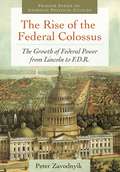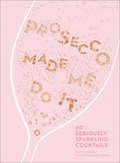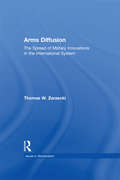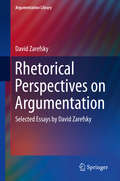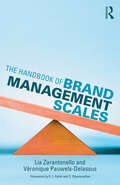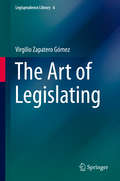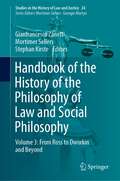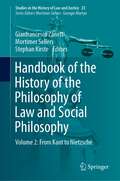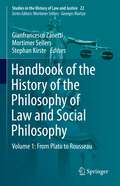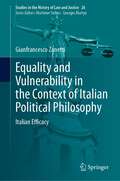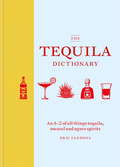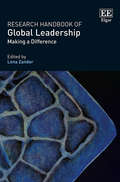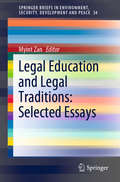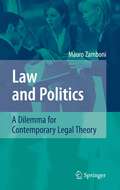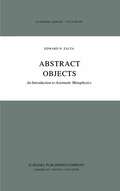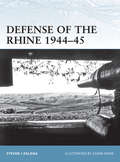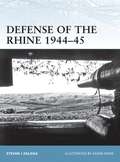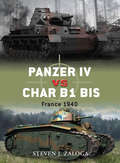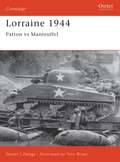- Table View
- List View
The Rise of the Federal Colossus: The Growth of Federal Power from Lincoln to F.D.R. (Praeger Series on American Political Culture)
by Peter ZavodnyikThis challenging book explores the debates over the scope of the enumerated powers of Congress and the Fourteenth Amendment that accompanied the expansion of federal authority during the period between the beginning of the Civil War and the inauguration of Franklin Delano Roosevelt.The Rise of the Federal Colossus: The Growth of Federal Power from Lincoln to F.D.R. offers readers a front-row seat for the critical phases of a debate that is at the very center of American history, exploring such controversial issues as what powers are bestowed on the federal government, what its role should be, and how the Constitution should be interpreted.The book argues that the critical period in the growth of federal power was not the New Deal and the three decades that followed, but the preceding 72 years when important precedents establishing the national government's authority to aid citizens in distress, regulate labor, and take steps to foster economic growth were established. The author explores newspaper and magazine articles, as well as congressional debates and court opinions, to determine how Americans perceived the growing authority of their national government and examine arguments over whether novel federal activities had any constitutional basis. Responses of government to the enormous changes that took place during this period are also surveyed.
The Rise of the Federal Colossus: The Growth of Federal Power from Lincoln to F.D.R. (Praeger Series on American Political Culture)
by Peter ZavodnyikThis challenging book explores the debates over the scope of the enumerated powers of Congress and the Fourteenth Amendment that accompanied the expansion of federal authority during the period between the beginning of the Civil War and the inauguration of Franklin Delano Roosevelt.The Rise of the Federal Colossus: The Growth of Federal Power from Lincoln to F.D.R. offers readers a front-row seat for the critical phases of a debate that is at the very center of American history, exploring such controversial issues as what powers are bestowed on the federal government, what its role should be, and how the Constitution should be interpreted.The book argues that the critical period in the growth of federal power was not the New Deal and the three decades that followed, but the preceding 72 years when important precedents establishing the national government's authority to aid citizens in distress, regulate labor, and take steps to foster economic growth were established. The author explores newspaper and magazine articles, as well as congressional debates and court opinions, to determine how Americans perceived the growing authority of their national government and examine arguments over whether novel federal activities had any constitutional basis. Responses of government to the enormous changes that took place during this period are also surveyed.
Prosecco Made Me Do It: 60 Seriously Sparkling Cocktails
by Amy ZavattoDo your ears perk up when you hear the telltale pop of a prosecco bottle? Do you think every drink is just a little bit nicer with bubbles? Prosecco is no longer just a sparkling wine, it’s a cultural phenomenon, a party in a glass.
Arms Diffusion: The Spread of Military Innovations in the International System (Issues in Globalization)
by THomas W. ZarzeckiWeapons proliferation is one of the most pressing global concerns following the end of the Cold War. Despite the absence of an overarching superpower conflict, armaments and related technologies have continued to spread throughout the international system. This has been particularly true in areas like East Asia and the Middle East, where the traditional two party arms races are not readily apparent. This text addresses these concerns and shortcomings using data on fourteen specific military technological innovations that diffused throughout the international system from 1960 to 1997.
Arms Diffusion: The Spread of Military Innovations in the International System (Issues in Globalization)
by THomas W. ZarzeckiWeapons proliferation is one of the most pressing global concerns following the end of the Cold War. Despite the absence of an overarching superpower conflict, armaments and related technologies have continued to spread throughout the international system. This has been particularly true in areas like East Asia and the Middle East, where the traditional two party arms races are not readily apparent. This text addresses these concerns and shortcomings using data on fourteen specific military technological innovations that diffused throughout the international system from 1960 to 1997.
Rhetorical Perspectives on Argumentation: Selected Essays by David Zarefsky (Argumentation Library #24)
by David ZarefskyThis book contains 20 essays tracing the work of David Zarefsky, a leading North American scholar of argumentation from a rhetorical perspective. The essays cohere around 4 general themes: objectives for studying argumentation rhetorically, approaches to rhetorical study of argumentation, patterns and schemes of rhetorical argumentation, and case studies illustrating the potential of studying argumentation rhetorically. These articles are drawn from across Zarefsky’s 45-year career. Many of these articles originally appeared in publications that are difficult to access today, and this collection brings the reader up to date on the topic.Zarefsky’s scholarship focuses on the role of language in political argumentation, the ways in which argumentation creates public knowledge and belief, the influence of framing and context on what is said and understood, the deployment of particular patterns and schemes of argumentation in public reasoning, and the influence of debate on politics and governance. All these topics are addressed in this book.Each of the conceptual essays includes brief application to specific cases, and five extended case studies are also presented in this volume. The case studies cover different themes: two explore famous political debates, the third focuses on presidential rhetoric across the course of United States history, the fourth on the arguments for liberalism at a time of political polarization, and the fifth on the contemporary effort to engage the United States with the Muslim world.This book is of interest to scholars in the fields of philosophy, logic, law, philosophy of law, and legal history. The range of topics and concepts addressed, the interplay of concepts and cases and the unifying perspective of rhetorical argumentation make this book a valuable read for students of argumentative practice, whether rhetorically or otherwise.
The Handbook of Brand Management Scales
by Lia Zarantonello Véronique Pauwels-DelassusThe Handbook of Brand Management Scales is a concise, clear and easy-to-use collection of scales in brand management. Scales are a critical tool for researchers measuring consumer insights, emotions and responses. Existing handbooks of marketing scales do not include (or include very few) scales related to brand management constructs. This book is the first to meet this need. Sample scales include brand personality, brand authenticity, consumer–brand relationships and brand equity. Each scale is included with a clear definition of the construct it is designed to benchmark, a description of the scale itself, how to use it and examples of possible applications in managerial and academic contexts. A much-needed reference point, this is a unique, vital and convenient volume that should be within reach of every marketing scholar's and manager's desk.
The Handbook of Brand Management Scales
by Lia Zarantonello Véronique Pauwels-DelassusThe Handbook of Brand Management Scales is a concise, clear and easy-to-use collection of scales in brand management. Scales are a critical tool for researchers measuring consumer insights, emotions and responses. Existing handbooks of marketing scales do not include (or include very few) scales related to brand management constructs. This book is the first to meet this need. Sample scales include brand personality, brand authenticity, consumer–brand relationships and brand equity. Each scale is included with a clear definition of the construct it is designed to benchmark, a description of the scale itself, how to use it and examples of possible applications in managerial and academic contexts. A much-needed reference point, this is a unique, vital and convenient volume that should be within reach of every marketing scholar's and manager's desk.
Anne Frank: Level 4 (PDF)
by Alexandra Zapruder National Geographic KidsNational Geographic Primary Readers is a high-interest series of beginning reading books that have been developed in consultation with education experts. The books pair magnificent National Geographic photographs with lively text by skilled children’s book authors across four reading levels. This level 4 reader brings an understanding of her historical significance to a whole new audience. Young readers will learn about the brave and tragic life of the young girl whose diary kept while in hiding from Nazis is one of the most important and insightful books of the World War II era. National Geographic Readers: Anne Frank explores not just the diary, but her life and the important role she played in 20th-century history. Level 4: Independent reader: Perfect for kids who are reading on their own with ease and are ready for more challenging vocabulary with varied sentence structures. They are ideal for readers of White and Lime books.
The Art of Legislating (Legisprudence Library #6)
by Virgilio Zapatero GómezAny contemporary state presents itself as committed to the “rule of law”, and this notion is perhaps the most powerful political ideal within the current global discourse on legal and political institutions. Despite being a contested concept, the rule of law is generally recognised as meaning that government is bound in all its actions by fixed and public rules, and that these rules respect certain formal requirements and are enforced by an independent judiciary. This book focuses on formal legality and the question of how to achieve good laws—a topic that was famously addressed by the 18th century enlightened thinkers, but also by prominent legal scholars of our time. Historically, the canon of “good legislation” demanded generality, publicity and accessibility, and comprehensibility of laws; non-retroactivity; consistency; the possibility of complying with legal obligations and prohibitions; stability; and congruency between enacted laws and their application. All these are valuable ideals that should not be abandoned in today’s legal systems, particularly in view of the silent revolution that is transforming our legality-based “states of law” into jurisdictional states. Such ideals are still worth pursuing for those who believe in representative democracy, in the rule of law and in the dignity of legislation. The idea for the book stemmed from the author’s parliamentary and governmental experience; he was responsible for the Government of Spain’s legislative co-ordination from 1982 to 1993, which were years of intensive legislative production. The more than five hundred laws (and thousands of decrees) elaborated in this period profoundly changed all sectors of the legal order inherited from Franco’s dictatorship, and laid the foundations of a new social and democratic system. For an academic, this was an exciting experience, which offered a unique opportunity to put the theory of legislation to the test. Reflecting and elaborating on this experience, the book not only increases scholarly awareness of how laws are made, but above all, improves the quality of legislation and as a result the rule of law.
Handbook of the History of the Philosophy of Law and Social Philosophy: Volume 3: From Ross to Dworkin and Beyond (Studies in the History of Law and Justice #24)
by Gianfrancesco Zanetti Mortimer Sellers Stephan KirsteThis Handbook discusses representative philosophers in the history of the philosophy of law and social philosophy, giving clear concise expert definitions and explanations of key personalities and their ideas. It provides an essential reference for experts and newcomers alike.
Handbook of the History of the Philosophy of Law and Social Philosophy: Volume 2: From Kant to Nietzsche (Studies in the History of Law and Justice #23)
by Gianfrancesco Zanetti Mortimer Sellers Stephan KirsteThis Handbook discusses representative philosophers in the history of the philosophy of law and social philosophy, giving clear concise expert definitions and explanations of key personalities and their ideas. It provides an essential reference for experts and newcomers alike.
Handbook of the History of the Philosophy of Law and Social Philosophy: Volume 1: From Plato to Rousseau (Studies in the History of Law and Justice #22)
by Gianfrancesco Zanetti Mortimer Sellers Stephan KirsteThis Handbook discusses representative philosophers in the history of the philosophy of law and social philosophy, giving clear concise expert definitions and explanations of key personalities and their ideas. It provides an essential reference for experts and newcomers alike.
Equality and Vulnerability in the Context of Italian Political Philosophy: Italian Efficacy (Studies in the History of Law and Justice #26)
by Gianfrancesco ZanettiOne of the main goals of this book is to determine if, in the works of some of the key authors in the history of Italian political philosophy, a notion of “efficacy” can be found. In legal philosophy, “efficacy” is the capacity a norm has to effectively influence citizens’ behavior. The “principle of efficacy” is that according to which an order or rule exists as such when it is followed effectively in practice. Here by “efficacy” I mean the idea that normative phenomena are self-justifying, without reference to extrinsic systems of value (such as “natural law”). The examinations of several texts undertaken here constitute reflections on this theme, without any claim to systematicity. They have been grouped together, roughly in historical order, by their common respect for the contexts within which they reason and reach decisions, which lends them a characteristic flavor of harsh realism that at times relies on a minimalist use of traditional normative categories.The second theme that emerges through the respective chapters (each of which constitutes the text for a lesson in a course for Ph.D. students) is that of the relationship between “equality” and “vulnerability.” Here the idea is to elaborate a concept of “vulnerability” that is not underpinned by what we in Italy call an “anthropology,” that is, a fixed notion of human nature. Instead this concept should be comprehensible and graspable solely on the basis of the recognition of decisions and actions that are merely “efficacious,” that function “for what they are, and what they do.” This recognition doesn’t even need to be explicitly articulated by these authors with any specific, deliberately conscious awareness.The goal is not to identify a precise tradition of thought, one which elaborates a given line of reflection, but rather to highlight certain “themes” that emerge in the texts examined, even as the authors write with and for their own specific, contingent set of motives, which differ from time to time and place to place. These authors include some who are widely known, such as Dante, Machiavelli, and Beccaria. At times they are figures who typify certain key historical episodes, such as the Risorgimento (Giuseppe Mazzini) or Fascism (Cesare Lombroso and Santi Romano), while others reflect certain aspects of a contemporary debate (Pasolini and the “Braibanti affair”).The book is based on lectures given for a 2021 Ph.D. Course at the University of California, Berkeley’s Department of Italian Studies.
The Tequila Dictionary: An A–Z of all things tequila, mezcal and agave spirits
by Eric Zandona"As comprehensive as it gets" The New York TimesA tequila revolution is taking place, with more and more people learning to appreciate the rich culture, craft and flavour to be found in this unique spirit. The Tequila Dictionary is the drinker's guide to this wonderful world. With hundreds of entries on tequila and agave spirits covering everything from history, culture and ingredients to distilling techniques, cocktails and the many varieties of tequila, spirits expert Eric Zandona explores the truth behind this truly captivating drink.
Research Handbook of Global Leadership: Making a Difference (Research Handbooks in Business and Management series)
by Lena ZanderThis timely Research Handbook brings together a group of internationally renowned scholars to take a fresh look at global leadership, querying in what way leaders, teams, firms, universities and business schools can make a difference in our world today and tomorrow. Presenting contemporary studies into a vibrant field, this Research Handbook offers empirical, theoretical, critical and pedagogical-based research, placing leaders firmly in their global cultural context. Chapters cover critical issues such as how leaders and teams can understand and incorporate cultural multiplicity, how firms can engage in responsible and inclusive leadership, and how universities and business schools can innovatively educate socially conscious global leaders to have an impact on our future. Comprehensive and insightful, this Research Handbook is critical reading for researchers of leadership seeking new avenues of enquiry. The broad and multilevel approach to the challenges and demands of contemporary leadership are also valuable for practitioners, business school teachers and students.
Legal Education and Legal Traditions: Selected Essays (SpringerBriefs in Environment, Security, Development and Peace #34)
by Myint ZanThis book deals with aspects of legal education and legal traditions. Part I includes chapters on teaching Law of the Sea, legal ethics and educating lawyers as ‘transaction cost engineers’ as well as comparison of teaching law in a refugee camp and in a Malaysian University. Part II on legal and philosophical traditions includes essays on what later philosophers would have commented on Plato’s arguments in the Crito regarding ‘absolute obligation to obey the law’ and what Socrates would have said on two conversations in the 19th century novel Uncle Tom’s Cabin regarding the morality and legality of harbouring runaway slaves. Part II concludes with two essays regarding the applicability of the Hart-Devlin debate on the ‘enforcement of morals’ vis-à-vis the International Criminal Court and an essay on what the historian Arnold Toynbee would have commented on the ‘contingency’ v ‘teleology’ debate between two palaeontologists the late Stephen Jay Gould and Simon Conway Morris.• Legal education of interest to legal educators and students • Legal, political, moral philosophy as well as philosophy of history of interest to law, philosophy and history teachers, postgraduate and under graduate students• Aspects of legal ethics for law teachers, students and legal professionals• Interdisciplinary studies regarding law and economics, law and literature, law and social justice for law, humanities, social science academics and students.
Law and Politics: A Dilemma for Contemporary Legal Theory
by Mauro ZamboniThis book reconstructs and classifies, according to ideal-typical models, the different positions taken by the major contemporary legal theories as to whether and how law relates to politics. It presents a possible explanation as to why different legal theories, though often reaching diametric results, somehow must still begin from common basic points.
Abstract Objects: An Introduction to Axiomatic Metaphysics (Synthese Library #160)
by E. ZaltaIn this book, I attempt to lay the axiomatic foundations of metaphysics by developing and applying a (formal) theory of abstract objects. The cornerstones include a principle which presents precise conditions under which there are abstract objects and a principle which says when apparently distinct such objects are in fact identical. The principles are constructed out of a basic set of primitive notions, which are identified at the end of the Introduction, just before the theorizing begins. The main reason for producing a theory which defines a logical space of abstract objects is that it may have a great deal of explanatory power. It is hoped that the data explained by means of the theory will be of interest to pure and applied metaphysicians, logicians and linguists, and pure and applied epistemologists. The ideas upon which the theory is based are not essentially new. They can be traced back to Alexius Meinong and his student, Ernst Mally, the two most influential members of a school of philosophers and psychologists working in Graz in the early part of the twentieth century. They investigated psychological, abstract and non-existent objects - a realm of objects which weren't being taken seriously by Anglo-American philoso phers in the Russell tradition. I first took the views of Meinong and Mally seriously in a course on metaphysics taught by Terence Parsons at the University of Massachusetts/Amherst in the Fall of 1978. Parsons had developed an axiomatic version of Meinong's naive theory of objects.
Defense of the Rhine 1944–45 (Fortress #102)
by Steven J. Zaloga Mr Adam HookThe Rhine River represented the last natural defensive barrier for the Third Reich in the autumn of 1944. Although Hitler had been reluctant to allow the construction of tactical defence lines in France, the final defense of the Reich was another matter. As a result, construction of a Rhine defence line began in September 1944. Steven J. Zaloga examines the multiple phases of construction undertaken to strengthen the Westwall (Siegfried Line), to fortify many of the border villages, and finally to prepare for the demolition of the Rhine bridges. Using detailed maps, colour artwork, and expert analysis, this book takes a detailed look at Germany's last line of defence.
Defense of the Rhine 1944–45 (Fortress)
by Steven J. Zaloga Adam HookThe Rhine River represented the last natural defensive barrier for the Third Reich in the autumn of 1944. Although Hitler had been reluctant to allow the construction of tactical defence lines in France, the final defense of the Reich was another matter. As a result, construction of a Rhine defence line began in September 1944. Steven J. Zaloga examines the multiple phases of construction undertaken to strengthen the Westwall (Siegfried Line), to fortify many of the border villages, and finally to prepare for the demolition of the Rhine bridges. Using detailed maps, colour artwork, and expert analysis, this book takes a detailed look at Germany's last line of defence.
Panzer IV vs Char B1 bis: France 1940 (Duel)
by Steven J. Zaloga Richard ChasemoreThe Battle of France in 1940 involved the first large-scale tank-against-tank battles in history. The massive clashes at Stonne, Hannant, and Gembloux involved hundreds of tanks on both sides, yet have faded from memory due to the enourmity of the French defeat. This book examines two of the premier opposing tanks of the Wehrmacht and the French Army, the German PzKpfw IV and the French Char B1 bis. With a complete history of the design, development, and deployment of these armoured fighting vehicles, the story of these great battles is once again brought to life.
Panzer IV vs Char B1 bis: France 1940 (Duel #33)
by Steven J. Zaloga Richard ChasemoreThe Battle of France in 1940 involved the first large-scale tank-against-tank battles in history. The massive clashes at Stonne, Hannant, and Gembloux involved hundreds of tanks on both sides, yet have faded from memory due to the enourmity of the French defeat. This book examines two of the premier opposing tanks of the Wehrmacht and the French Army, the German PzKpfw IV and the French Char B1 bis. With a complete history of the design, development, and deployment of these armoured fighting vehicles, the story of these great battles is once again brought to life.
Lorraine 1944: Patton versus Manteuffel (Campaign)
by Steven J. Zaloga Tony BryanIn the wake of the defeat in Normandy in the summer of 1944, Hitler planned to stymie the Allied advance by cutting off Patton's Third Army in the Lorraine with a great Panzer offensive. But Patton's aggressive tactics continued to thwart German plans and led to a series of violent armored battles. The battle-hardened Wehrmacht confronted the better-equipped and better-trained US Army. The Germans managed to re-establish a fragile defensive line but could not stop the US Army from establishing bridgeheads over the Moselle along Germany's western frontier. Campaigns 5, 24, 74 and 75 are also available in a single volume special edition as 'Into the Reich'.
Lorraine 1944: Patton versus Manteuffel (Campaign #75)
by Steven J. Zaloga Tony BryanIn the wake of the defeat in Normandy in the summer of 1944, Hitler planned to stymie the Allied advance by cutting off Patton's Third Army in the Lorraine with a great Panzer offensive. But Patton's aggressive tactics continued to thwart German plans and led to a series of violent armored battles. The battle-hardened Wehrmacht confronted the better-equipped and better-trained US Army. The Germans managed to re-establish a fragile defensive line but could not stop the US Army from establishing bridgeheads over the Moselle along Germany's western frontier. Campaigns 5, 24, 74 and 75 are also available in a single volume special edition as 'Into the Reich'.
